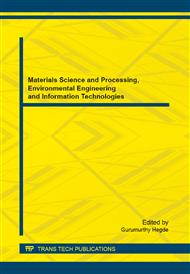[1]
John G, Speer,K. Matlock, Recent developments in Low-Carbon sheet steels, J. JOM. 54, (2002)1543-1851.
DOI: 10.1007/bf02700981
Google Scholar
[2]
JiangHaitao, KangYonglin, YuHao, Research progress and development of bake hardening steel sheet for automobile, J. Automobile technology and material. Issue3 (2005)1-7.
Google Scholar
[3]
H. Alihosseine, K. Dehghani, Bake hardening of ultra-fine grained low carbon steel produced by constrained groove pressing, J. Materials Science and Engineering. A549 (2012)157-162.
DOI: 10.1016/j.msea.2012.04.024
Google Scholar
[4]
B. Soenen, A.K. De, S. Vandeputte, etal, Competition between grain boundary segregation and Cottrell atmosphere formation during static aging in ultra-low carbon bake hardening steels, J. Acta Materialia. 52 (2004)3483-3492.
DOI: 10.1016/j.actamat.2004.03.046
Google Scholar
[5]
M. Weller, The Snoek relaxation in bcc metals-From steel wire to meteorites, J. Materials Science and Engineering A. 442, (2006)21-30.
DOI: 10.1016/j.msea.2006.02.232
Google Scholar
[6]
Simeon Ikechukwu, Neife, Erwin Pink, Hein Peter Stuwe, The isothermal precipitation behavior in a low-carbon steel at low temperatures investigated by internal friction, J. Scripta Metallurgica et Materialia. Volume30. (1994)361-366.
DOI: 10.1016/0956-716x(94)90389-1
Google Scholar
[7]
G. Haneczok, M. Weller, Analysis of internal friction spectra caused by Snoek-type relaxtions, J. Journal of the Less-common Metals. 159, (1990)269-276.
DOI: 10.1016/0022-5088(90)90154-c
Google Scholar
[8]
M. Weller, G.Y. Li, J.X. Zhang, etal, Accurate determination of activation enthalpies associated with the stress-induced migration of oxygen or nitrogen in tantalum and niobium, J. Acta Metall. 29 (1981)1047-1054.
DOI: 10.1016/0001-6160(81)90056-0
Google Scholar
[9]
C. A. Wert, Diffusion Coefficient of C in α-Iron, J. Phys. Rev. 79(1950)601.
Google Scholar
[10]
Charles A. Wert, Precipitation from Solid Solutions of C and N in α-Iron,J. Phys. (1949) 943.
Google Scholar
[11]
C. Wert, J. Marx, A new method for determining the heat of activation for relaxation processes, J. Acta Metall. 1, (1953)113-115.
DOI: 10.1016/0001-6160(53)90047-9
Google Scholar
[12]
R. Bagramov, D. Mari, W. Benoit, Internal friction in a martensitic high-carbon steel, J. Philosophical Magazine A. 81(2001)2797-2808.
DOI: 10.1080/01418610108217165
Google Scholar


